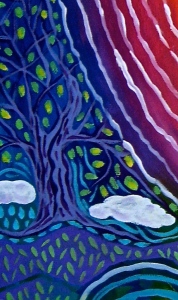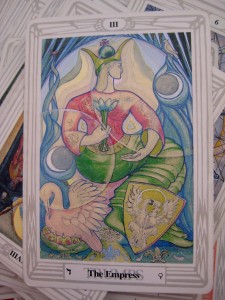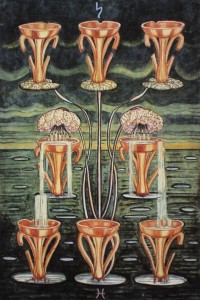
– Art by Jan Ketchel
Individuation requires the full realization of the seed of who we are. As the seed cracks open and begins its arduous journey upward, through the darkness of the earth, it encounters many obstacles on its voyage to the light of day.
Each seed will have a different journey, be it to stressfully twist around subterranean boulders or to find a quick ascent through loose sandy soil. The journey of each seed will uniquely shape its unfolding individuation. The journey of the seed cannot be separated from its flowering; every step of the journey must be accepted and included for the full realization of the individual. To reject any part of the journey is to literally cut off a limb of the truth of who we are and the truth of our complete journey.
Trauma is a crushing blow to a growing seed. Trauma will impact the journey to the light. However, trauma is a legitimate part of who we are and must be honored and welcomed into the fold of our wholeness if we are to achieve individuation and fully flower. Ultimately, acceptance means welcoming every part of our experience into our wholeness with open arms.
The challenge of acceptance is to allow all of our experiences to be fully known to ourselves physically, emotionally, and cognitively. The journey of trauma frequently requires us to shut down the knowing of our experiences so that we may continue to grow our infrastructure according to the dictates of the seed. At a certain point, however, the unfolding of the seed will require that we use our developed infrastructure, or adult self, to recapitulate the experiences of our lost self in order to gather our fuller self to take the next turn in the journey deeper into life, toward our fuller flowering.
Carlos Castaneda, of the shamanic world, suggested that we begin this part of the journey by suspending all judgments and allowing ourselves to gain pure access to our tucked-away, unfamiliar experiences as we recapitulate. Full access will require that we allow our instinctive self to come on line and reset our central nervous system. Peter Levine and Francine Shapiro, of the world of psychology, have made great modern strides in methodologies that value and access the body’s innate ability to both a) reset itself once consciousness is gained and strengthened enough to assume responsibility for lifting its old defenses and to b) fully join the deeper process of reconciliation.

– Photo by Jan Ketchel
During recapitulation, the body will take us on a journey of physical sensation as it relives and releases from its frozen moments of trauma. The heart will release its sadness in tears and rages, in silent or violent gestures and screams. Our minds will clarify ancient frozen negative beliefs as we reset with the truth, aided by the fuller perspective afforded by the joining of the adult self with its younger frozen counterpart.
Popular concepts like “Letting go” and “Forgiveness” attempt to capture this process but actually miss the mark. Simply letting go and moving on offers no deeper compensation or healing value, as our deepest core issues, if not resolved, will lie festering, inhibiting fuller flowering and enjoyment of life.
During recapitulation nothing is rejected or reframed for more compatible digestion; all life experiences are equally valued and accepted as truths of our personal history, as valid parts of our individuation process—no regrets. Regrets alert us to issues of non-acceptance, signaling the need for deeper recapitulation.
Forgiveness presumes we hold some power over another’s journey that should be released for our own healing. All beings must reconcile with their own truths. No one can release another from the full burden and encounter with their own actions. The true mechanism of healing is to release the self of the burden of another person’s journey while fully reconciling and owning one’s own.
While fully accepting the impact of another upon the self, the energy of the other is released back to the other to reconcile for themselves. There is no obligation to that other. However, full completed release requires that there be total transparency and no emotional attachment to the events experienced with that other person; the truth simply is what it is. Full acceptance leads to emotional neutrality and the freedom to really move on.

– Photo by Jan Ketchel
Just as the shell of the seed is shed on its upward journey to the light, so are all emotional attachments to the events of our lives that have shaped and delivered us to now shed during recapitulation so that we may be fully alive and fully energetically available for the next adventure. The past—fully known, fully accepted, fully resolved, energetically and otherwise—recedes as we are freed to flower and experience the joys of new life.
On the ever-unfolding journey,
Chuck












